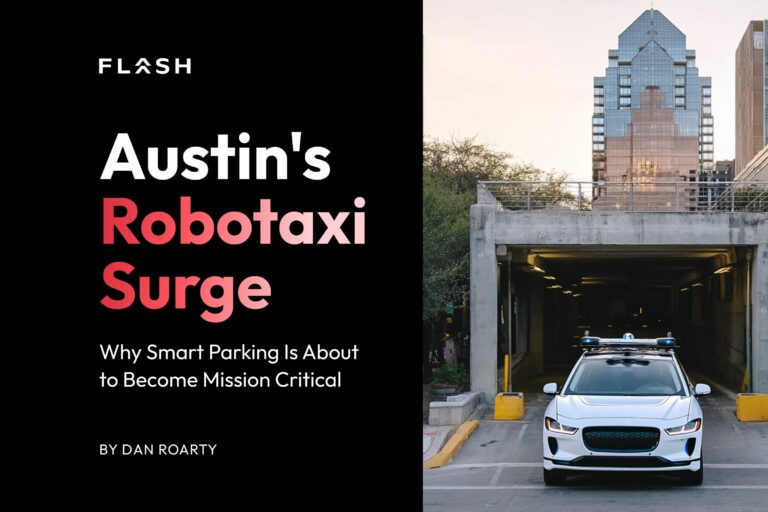Austin, home to Flash HQ, is undergoing arguably the country’s biggest stress test for autonomous mobility. In hard-to-miss news, Tesla officially launched robotaxi service in June, starting small but ramping to 1,000 cars quickly. Add that to Waymo’s existing fleet of about 100 AVs and a handful of smaller pilots already navigating our streets, and we’re looking at a robotaxi population rivaling our entire pre COVID downtown taxi count – in a matter of months.
The core insight: Where robotaxis rest determines whether cities move or gridlock
The speed of autonomous vehicles’ arrival and exponential rate at which they’re predicted to scale have raised questions about their impact. Safety, justifiably, dominates conversations and headlines to date.
As deployments scale, safety concerns will quickly yield to an equally potent challenge: the prospect of congestion and gridlock from idle AVs. Anecdotally, sightings of empty robotaxis in daily commutes come up in casual conversations as often as the weather or our collective pastime of waxing nostalgic about ‘old Austin.’
Empirically, close to half of complaints Austin’s Transportation & Public Works department logged about robotaxis in the first 17 months came from emergency responders reporting stalled AVs had blocked their routes. A notable case from September 2023 involved about 20 AVs gridlocked west of the University of Texas campus – they blocked the street in both directions and spilled into the oncoming lane, prompting local city council members to raise congestion impacts at the next mobility hearing.
These incidents hint at a hard operational truth: roughly 40 percent of robotaxi miles are “deadhead” trips without passengers, an unsettling proposition for traffic flow if streets absorb those empty miles. In practical terms, this means we’re looking at a future where congestion could ramp as quickly as AVs scale and impede the real and perceived value communities derive from autonomous mobility, threatening support for its expansion.
Embracing and solving for idle trips to prevent congestion challenges – before robotaxis begin operating in cities at scale – benefits all stakeholders, driverless fleet operators included.
A new mission for parking facilities
Off street parking assets are perfectly positioned not only to absorb idle robotaxi trips but also to become the staging, charging and servicing backbone that cities will need to make autonomous mobility at scale a reality. The fundamentals already support this shift:
- Austin, like most cities, has plentiful underutilized parking. Our estimates, based on publicly available data, count 240,000 structured and surfaced stalls in Austin’s urban core, a third of which sit vacant most evenings. Upgrading even a fraction of these parking assets with camera based access control, reservable Level 2 charging and open API data feeds can convert a passive asset into an AV ready depot.
- Fleet economics demand staging efficiency and proximity. AVs must routinely wait or reposition between fares, recharge and undergo cleaning and maintenance, and they need places to do so. Situating these staging areas near transit corridors not only gets idle robotaxis off the streets swiftly, it also returns them to service quickly with the potential to convert previously unproductive minutes to fares. For robotaxi operators, cutting idle time is pure margin.
- Property owners and operators who supply those parking-turned-staging slots will find equally compelling economics. Digitally managed parking and charging in human driver contexts lifts yield as much as 30 to 40 percent according to our data. Fleet operators will expect guaranteed access, reliable charging, and seamless API integration and pay premium rates to secure it.
Pushing idle robotaxis from the street and into purpose-built staging hubs will relieve surface street pressure as deployments grow. By retrofitting underutilized parking assets with reservable bays, charging and quick-turn service lanes, property owners, parking operators and fleet operators can partner together to create a sustainable ecosystem.
Looking ahead: Three moves property and parking owners can make now
The technology already exists to transform parking assets into AV-ready depots. License plate recognition with 98 percent exact match accuracy, sophisticated reservation engines, and networks that already reach 450 million driver touchpoints across 16,000 locations nationwide – Flash has these solutions in deployment now, and property owners can leverage them with three strategic moves:
- Audit your readiness. Map nightly vacancy rates, electrical capacity, and connectivity across every urban Austin asset. The facilities that can guarantee 24/7 availability with real-time data feeds will command the highest premiums.
- Lock in agreements before robotaxi deployments ramp. First movers set the market rate. With the coming need for AV staging, early partnerships will define pricing for years to come.
- Think in terms of mobility infrastructure, not parking. In an autonomous future, your parking facilities become essential urban infrastructure that give fleet operators margin and give cities congestion relief that can be quantified in terms of how each off street stall removes deadhead laps from city streets.
Bottom line
The conversation around autonomous vehicles will shift from “Are they safe?” to “Will they clog our streets?” Commercial parking assets already hold the answer: they can readily transform from underutilized facilities into AV staging hubs, providing critical infrastructure for autonomous mobility to actually keep us moving. The curb won’t scale, but your garages already have.
Let’s connect if you’re thinking about AV readiness, staging economics, or turning your parking assets into tomorrow’s mobility infrastructure. The window to shape this market is measured in months, not years.

